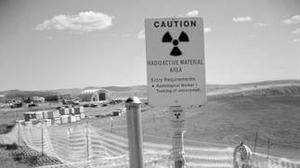Nuclear waste and contaminationCold War nuclear legacy challenges science, society
Fifty years of U.S. nuclear weapons production, and government-sponsored nuclear energy research and production, generated contaminated soil and groundwater covering two million acres in thirty-five states; for most of that period, the U.S. government did not have environmental structures, technologies, or infrastructure to deal with the problem

Contamination is the long lasting legacy of the Cold War // Source: ananuclear.org
Seven papers published in the current issue of Technology and Innovation, Proceedings of the National Academy of Inventors report on efforts by the U.S. Department of Energy (DOE) to ensure continued safe and secure storage and disposition of fifty years worth of spent nuclear fuel, surplus nuclear materials, and high-level wastes at DOE facilities.
“Technology, innovation, development and deployment are key elements in the DOE cleanup effort,” said Yvette T. Collazo, Paula G. Kirk, and A. Alan Moghissi of the DOE’s Office of Environmental Management and authors of a lead-in editorial outlining the issues addressed by papers — issues that range from how to prioritize projects to the nuts and bolts of advanced mediation efforts. “The DOE has implemented a new approach and business model to incorporate innovative strategies that build on scientific advancements to reduce the legacy footprint.”
EurekaAlert, citing a Florida Science Communications news release, notes that during 50-plus years of nuclear weapons production and government-sponsored nuclear energy research and production that generated contaminated soil and groundwater covering two million acres in thirty-five states, the U.S. government did not have environmental structures, technologies, or infrastructure to deal with the legacy.
“Many of the excess facilities awaiting deactivation and decommissioning are one-of-a-kind or unique to the DOE, with unprecedented scope and complexity,” said the authors. “In many cases, the necessary technologies are not yet developed or, if developed, they require significant re-engineering to fit DOE needs.”
As outlined and evaluated by papers published in the current issue of Technology and Innovation, Proceedings of the National Academy of Inventors, recent DOE efforts have both offered and analyzed remediation technology projects; technical reviews for evaluating system-level modeling and simulation; remedies for subsurface contamination; engineering systems for predicting the fate and transport of wastes; and communication models for the technical communities. The new models also include designs for collaboration between regulators, stakeholders, field offices, contractors, scientists, and technology developers.
Among the articles collected in the issue:
— A critical review of technology and safe practices in spent nuclear fuel transport and storage found that mid-term storage (up to several decades) is feasible, yet long-term storage (up to 100 years) needs strengthened technology and management practices (Gary R. Peterson, DOE, Office of Environmental Management).
— Analysis of the success of polyphosphate remediation for uranium sequestering in areas where uranium groundwater contamination exceeds EPA limits (Dawn W. Wellman, Pacific Northwest National Lab, et al.). — An External technical Review team analyzed software and simulation modeling tools to support the planning for life-cycle liquid waste disposition and found that new tools are needed (John R. Shultz, DOE, Office of Waste Processing, et al.).
— A description of the development of a state-of-the-art tool and approach for predicting subsurface flow and contaminant transport behavior in complex geological systems (Mark K. Williams, DOE, Office of Environmental Management, et al.).
— Also, the DOE’s Office of Environmental Management, responsible for the cleanup of the U.S. nuclear weapons programs’ wastes, created the Advanced Remediation Technologies (ART) projects that access private sector expertise for developing radioactive waste disposition technologies (Gary R. Peterson, DOE, Office of Environmental Management).
— The Cementitious Barriers Partnership collaborated with the Department of Energy to devise simulation tools to estimate and improve the performance of cement barriers in nuclear applications (Daryl R. Haefer, DOE, Office of Environmental Management and Sharon L. Marra, Savannah River National Laboratory).
— Finally, Process Knowledge (PK) is a key resource for the DOE Office of Environmental Management’s efforts to deactivate and decommission facilities for disposition. This article explains how the elements of the PK body of knowledge were developed (Paula G. Kirk, DOE, Office of Environmental Management, et al.).
In total, thirty-five authors from eleven institutions contributed to the seven papers in the current issue. Those institutions include the DOE, Pacific Northwest Laboratory, Champion Technologies, Cogentus Consulting, Argonne National Laboratory, the School of Engineering, Vanderbilt University, Oak Ridge National Laboratory, Lawrence Berkeley National Laboratory, Los Alamos National Laboratory, and the Savannah River National Laboratory.
The National Academy of Inventors is a non-profit organization comprising U.S. and international universities and non-profit research institutes. It was founded in 2010 at the University of South Florida to recognize and encourage inventors with a patent issued from the U.S. Patent and Trademark Office, enhance the visibility of university technology and innovation, encourage the disclosure of intellectual property, educate and mentor innovative students, and translate the inventions of its members to benefit society.
